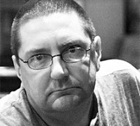Fairfax CEO Greg Hywood faced a 40-minute interrogation yesterday. As the relatively new CEO of Fairfax, he’s a good performer. Hats off. But there’s an anomaly in his message that just can’t be ignored.
Hywood was speaking at the Mumbrella360 media and marketing conference in Sydney. Well, not speaking. Being interviewed live by mUmBRELLA editor Tim Burrowes.
The audience numbered maybe 80. Journalists filled the front row, with The Australian’s leather-booted Caroline Overington and her colleague, James Chessell, right in his face, flanked by me and a journo from The Age one side, the Pacific Area Newspaper Publishers’ Association the other.
Now on the one hand, Hywood’s message is that everything is proceeding to plan.
“[Fairfax] has redefined itself,” he said. “What we now do is through our content, through our journalism, create audiences.”
“It almost makes it sound like you’ve come in [as CEO] on the end of the process and it’s all sorted,” Burrowes said.
“Well, I mean, this started in the ’90s,” said Hywood. “People at Fairfax went to Silicon Valley. I was one of them.” When classified advertising moved online, Fairfax captured 22% of that market, and it has now transformed itself into a “news, media and digital transactions company”.
This message of clarity and stability is essential when shareholders have seen the price drop nearly 30% since Hywood became CEO in February. His calm, measured responses do deliver that message.
But on the other hand, Hywood wants us to reserve our judgment because we’re actually still at the beginning of a process.
The new iPad apps for the SMH and The Age have seen 75,000 downloads in the first week, and while he’s “thrilled” at that figure he was keen to stress that “it’s early days yet”.
“It’s early days yet” was Hywood’s response to several questions. Was I detecting a certain fingers-crossed wishing, hoping, perhaps even fear about the future?
“Not a bit,” he said. “It’s early days yet for this particular technology. That’s the context in terms of what I’m talking about … Publishers are putting a new product into a technology rather than with the assumption that there’s a market. ‘It’s early days yet.’ It’s a reasonable point to make. It’s actually frank, isn’t it? Yep? You got the answer? I mean, I’m just saying if you’ve got the answer to that, to what this is going to do, I’d love to hear it.”
Hywood went on to stress that Fairfax was a multifaceted business, not just the SMH and The Age, but also an enormous regional newspapers, Trade Me in New Zealand, the radio network, a “very healthy” printing business and more.
“This is a company with $3 billion in revenue, 12,000 employees,” he said. “People look at it through the prism of these mastheads, and that seems to be very city-centric debate.”
He’s right, of course. But the share market is all about perception and, like it or not, the perception of Fairfax is indeed all about the big metropolitan mastheads — even when, as Hywood reminds us, things like The Sydney Morning Herald are “over-arching brands” for different media products on paper and online, with different content tailored for different demographics.
And, like it or not, the iPad is being seen as the saviour of what were once “only” newspaper companies and as representing their future. As I hardly need to point out, that world is very different.
“The interesting thing about the iPad and the tablets is that normally in publishing what you do is identify a market and create a product for it. This is different,” Hywood said. “There’s a piece of technology. You create a product for the technology in the expectation there’ll be a market.”
Expectation. Hoping. Wishing. A subtle spectrum, is it not?








Fairfax shares are 99 cents today and if Hywood keeps talking about stuff he did in 1996 it will be 5 cents in no time.
By the way, when is Crikey going to get an iPad app….?